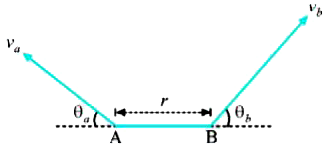Two particles, A and B are moving in concentric circles in anticlockwise sense in the same plane with radii of the circles being γA=1.0m and γB=2.0m respectively. The particles move with same angular speed of ω=4rad/s. Find the angular velocity of B as observed by A if
(a) Particles lie on a line passing through the centre of the circle.
(b) Particles lie on two perpendicular lines passing through the centre.
The correct Answer is:(a) ω=4rad/s (b) ω=4rad/s
Step by step video, text & image solution for Two particles, A and B are moving in concentric circles in anticlockwise sense in the same plane with radii of the circles being gamma_(A) = 1.0 m and gamma_(B) = 2.0 m respectively. The particles move with same angular speed of omega = 4 rad//s. Find the angular velocity of B as observed by A if (a) Particles lie on a line passing through the centre of the circle. (b) Particles lie on two perpendicular lines passing through the centre. by Physics experts to help you in doubts & scoring excellent marks in Class 11 exams.
Updated on:21/07/2023Topper's Solved these Questions
- KINEMATICSBOOK - ARIHANTCHAPTER - KINEMATICSEXERCISE - Level 3
33 Videos
- KINEMATICSBOOK - ARIHANTCHAPTER - KINEMATICSEXERCISE - Level 3
33 Videos
- HEAT TRANSFERBOOK - ARIHANTCHAPTER - HEAT TRANSFEREXERCISE - Heat Transfer
45 Videos
- KINETIC THEORY OF GASESBOOK - ARIHANTCHAPTER - KINETIC THEORY OF GASESEXERCISE - Level 3
4 Videos
Similar Questions
A particle moves in a circle of radius 4m with a linear speed of 20m/s. Find the angular speed.
View SolutionTwo particles A and B are moving uniformly in a plane in two concentric circles. The time period of rotation is TA=8 minute and TB=11 minute respectively for the two particles. At timet=0, the two particles are on a straight line passing through the centre of the circles. The particles are rotating in same sense. Find the minimum time when the two particles will again fall on a straight line passing through the centre.
View Solution
Knowledge Check
A particle moves in a circle of radius 20 cm with linear speed of 10 m/s. Find the angular velocity
A500radsB150radsC50radsD15radsTwo particles A and B are moving as shown in figure. At this moment of time, the angular speed of A with respect to B is?
 A(va+vb)rB(va−vb)rC(vbsinθb−vasinθa)ri n anticlockwise directionD(vbsinθb+vasinθa)ri n anticlockwise direction
A(va+vb)rB(va−vb)rC(vbsinθb−vasinθa)ri n anticlockwise directionD(vbsinθb+vasinθa)ri n anticlockwise directionA particle is moving with uniform speed 0.5m/s along a circle of radius 1m then the angular velocity of particle is (in rads−1)
A2B1.5C1D0.5
A particle moves in a circle of radius 4 m with a linear velocity of 20ms−1. Find the angular velocity.
View SolutionA particle moves with constant angular velocity in a circle. During the motion its
View SolutionTwo particles A and B are moving in uniform circular motion in concentric circles of radii rA and rB with speed uA and uB respectively. Their time period of rotation is the same. The ratio of angular speed of a to that of B will be:
View SolutionTwo particles A and B are moving in uniform circular motion in concentric circles of radii rA and rB with speed uA and uB respectively. Their time period of rotation is the same. The ratio of angular speed of a to that of B will be:
View SolutionA particle moves in a circle with constant angular velocity ω about a point P on its circumference. The angular velocity of the particle about the centre C of the circle is
View Solution